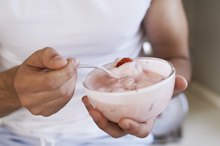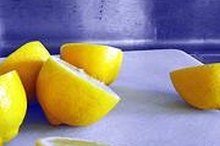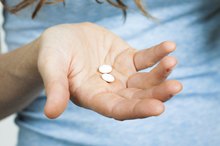What does fact checked mean?
At Healthfully, we strive to deliver objective content that is accurate and up-to-date. Our team periodically reviews articles in order to ensure content quality. The sources cited below consist of evidence from peer-reviewed journals, prominent medical organizations, academic associations, and government data.
- Harvard Health Publishing: Bacterial Vaginosis (Gardnerella Vaginitis): What Is It?
- Centers for Disease Control and Prevention: Bacterial Vaginosis (BV) Statistics
The information contained on this site is for informational purposes only, and should not be used as a substitute for the advice of a professional health care provider. Please check with the appropriate physician regarding health questions and concerns. Although we strive to deliver accurate and up-to-date information, no guarantee to that effect is made.
Can Avoiding Certain Foods Prevent Bacterial Vaginosis?
According to the Centers for Disease Control and Prevention, in women aged 15 to 44, bacterial vaginosis, or BV, is the most common vaginal infection 3. BV occurs when the natural flora or good bacteria, mostly lactobacilli, are replaced by large numbers of bad bacteria. Harvard Health Publishing suggests that BV is the most common cause of abnormal vaginal odor and discharge 2. When Harvard Health Publishing — above 4.5 — it creates a favorable environment for the overgrowth of bad bacteria 2. This proliferation causes an infection that could potentially lead to complications in the uterus and fallopian tubes. Although bacterial vaginosis is typically treated with antibiotics, diet changes can also help manage bacterial overgrowth in your vagina.
If you are experiencing serious medical symptoms, seek emergency treatment immediately.
Read more: Diet for Bacterial Vaginosis
Tips
Limiting sugar intake can help prevent bacterial vaginosis.
Causes of BV
Causative factors for bacterial vaginosis include:
- a new sex partner or multiple sex partners
- douching
- using intrauterine contraceptive devices
- taking broad-spectrum antibiotics
- not using condoms
- as sperm alkalinize the vagina
According to Body Ecology, rinsing your vagina in a hot bath mixed with 1 to 2 cups of apple cider vinegar after intercourse can help prevent vaginal infections.
Food and Bacterial Overgrowth
Diet for Bacterial Vaginosis
Learn More
Certain foods can promote bacterial overgrowth by creating a more favorable environment within the body where the bacteria can thrive and multiply. Sugar and foods that either contain sugar or turn to sugar in the body are the biggest culprits and the most important food items to avoid. Sugar promotes inflammation and acts as food for the bad bacteria. Foods that dehydrate the body, saturated fats and refined flour products are also foods to avoid with bacterial vaginosis 1.
- Certain foods can promote bacterial overgrowth by creating a more favorable environment within the body where the bacteria can thrive and multiply.
Bacterial Vaginosis Diet
Whether you currently have BV or want to avoid an infection, there are specific foods to avoid to help keep a healthy ecosystem of flora throughout the body. These foods include alcohol; coffee; fast foods; saturated fats; foods that contain molds, such as peanuts; citrus fruits; fruits with a high glycemic index, such as bananas; fermented foods; processed foods; breads and pasta made with refined white flour; and anything high in carbohydrates.
Avoid Food Allergens
Foods That Cause Yeast Infections
Learn More
Food allergens should also be avoided. The top allergenic foods include dairy products, such as milk and cheese; wheat and gluten; eggs; corn; soy; and nuts, including peanuts due to their mold content. Although yogurt contains lactobacilli, it may be best to avoid eating it because of the dairy content and instead use a probiotic supplement formulated with lactobacilli.
- Food allergens should also be avoided.
- Although yogurt contains lactobacilli, it may be best to avoid eating it because of the dairy content and instead use a probiotic supplement formulated with lactobacilli.
Other BV Considerations
In addition to eating a diet rich in whole foods and avoiding sugars, refined carbohydrates and food allergens, it's also important to drink adequate amounts of filtered water every day as part of your bacterial vaginosis diet. The rule of thumb is to drink half your body weight in ounces of water daily, according to Indiana University's Health Center 4. Your doctor can best advise you about which foods to avoid and which ones to eat and can work with you to develop a treatment plan that's best for you.
Read more: 4 Ways to Cure Bacterial Vaginosis
Related Articles
References
- Body Ecology: Bacterial Vaginosis: What It Is, How to Recognize It and How to Overcome It and Avoid It for Good
- Centers for Disease Control and Prevention: Bacterial Vaginosis (BV) Statistics
- Indiana University Health Center: Drink Healthy Beverages
- Kairys N, Garg M. Bacterial Vaginosis. [Updated 2019 May 4]. In: StatPearls [Internet]. Treasure Island (FL): StatPearls Publishing; 2019 Jan-. Available from: https://www.ncbi.nlm.nih.gov/books/NBK459216/
- Reiter S, Kellogg spadt S. Bacterial vaginosis: a primer for clinicians. Postgrad Med. 2019;131(1):8-18.
- Bilardi J, Walker S, McNair R, et al. Women's Management of Recurrent Bacterial Vaginosis and Experiences of Clinical Care: A Qualitative Study. PLoS One. 2016;11(3):e0151794. Published 2016 Mar 24. doi:10.1371/journal.pone.0151794
- Koumans EH, Sternberg M, Bruce C, et al. The prevalence of bacterial vaginosis in the United States, 2001-2004; associations with symptoms, sexual behaviors, and reproductive health. Sex Transm Dis. 2007;34(11):864-9.
- Kumar N, Behera B, Sagiri SS, Pal K, Ray SS, Roy S. Bacterial vaginosis: Etiology and modalities of treatment-A brief note. J Pharm Bioallied Sci. 2011;3(4):496–503. doi:10.4103/0975-7406.90102
- McDonald HM, Brocklehurst P, Gordon A. Antibiotics for treating bacterial vaginosis in pregnancy. Cochrane Database Syst Rev. 2007;(1):CD000262. Published 2007 Jan 24. doi:10.1002/14651858.CD000262.pub3
- Kairys N, Garg M. Bacterial Vaginosis. [Updated 2019 May 4]. In: StatPearls [Internet]. Treasure Island (FL): StatPearls Publishing; 2019 Jan-.
- Kumar N, Behera B, Sagiri SS, Pal K, Ray SS, Roy S. Bacterial vaginosis: Etiology and modalities of treatment-A brief note. J Pharm Bioallied Sci. 2011;3(4):496–503. doi:10.4103/0975-7406.90102
- Muzny CA, Schwebke JR. Pathogenesis of Bacterial Vaginosis: Discussion of Current Hypotheses. J Infect Dis. 2016;214 Suppl 1(Suppl 1):S1–S5. doi:10.1093/infdis/jiw121
- Mackelprang RD, Scoville CW, Cohen CR, et al. Toll-like receptor gene variants and bacterial vaginosis among HIV-1 infected and uninfected African women. Genes Immun. 2015;16(5):362–365. doi:10.1038/gene.2015.13
- Money D. The laboratory diagnosis of bacterial vaginosis. Can J Infect Dis Med Microbiol. 2005;16(2):77–79. doi:10.1155/2005/230319
- Cook RL, Reid G, Pond DG, Schmitt CA, Sobel JD. Clue cells in bacterial vaginosis: immunofluorescent identification of the adherent gram-negative bacteria as Gardnerella vaginalis. J Infect Dis. 1989;160(3):490-6.
- Bradshaw CS, Sobel JD. Current Treatment of Bacterial Vaginosis-Limitations and Need for Innovation. J Infect Dis. 2016;214 Suppl 1(Suppl 1):S14–S20. doi:10.1093/infdis/jiw159
- Menard JP. Antibacterial treatment of bacterial vaginosis: current and emerging therapies. Int J Womens Health. 2011;3:295–305. doi:10.2147/IJWH.S23814
- Homayouni A, Bastani P, Ziyadi S, et al. Effects of probiotics on the recurrence of bacterial vaginosis: a review. J Low Genit Tract Dis. 2014;18(1):79-86.
- Muzny CA, Schwebke JR. Pathogenesis of Bacterial Vaginosis: Discussion of Current Hypotheses. J Infect Dis. 2016;214 Suppl 1(Suppl 1):S1–S5. doi:10.1093/infdis/jiw121
- Allworth, J. and Peipert, J. Severity of Bacterial Vaginosis and the Risk of Sexually Transmitted Infection.Am J Obstet Gynecol. 2011; 205(2):113.e1-113.e6. doi:10.1016/j.ajog.2011.02.060.
- Bagnall, P. and Rizzolo, D. Bacterial vaginosis: A practical review.J Am Acad Phys Assist. 2017; 30(12):15-21. doi:10.1097/01.JAA.0000526770.60197.fa.
- CDC. Bacterial Vaginosis (BV) Statistics: Bacterial vaginosis is the most common vaginal infection in women ages 15-44. Updated December 17, 2015.
- Centers for Disease Control and Prevention. 2015 Sexually Transmitted Diseases Treatment Guidelines: Bacterial Vaginosis. Atlanta, Georgia; updated June 4, 2015.
- Hainer, B. and Gibson, M. Vaginitis: Diagnosis and Treatment. Am Fam Physician. 2011; 83(7):807-815.
Writer Bio
Dr. Gayl Hyde began copywriting for advertising agencies in 1991. She has worked on health-related projects for "Men's Health" magazine and "New York Magazine," with emphasis on integrative and natural health care. She received a doctorate in medicine in 2009 from Southwest College of Naturopathic Medicine in Tempe, Ariz.









